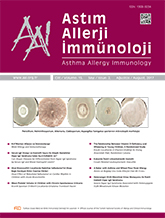


Objective: Vitamin D (VD) plays a critical role in immunological processes and studies have been conducted to investigate its role in the development of several allergic and infectious diseases. The aim of this study was to determine the factors that affect the 25(OH)D level in children, and also to assess the relationship between VD and wheezing, allergy, and infection.
Materials and Methods: Sixty-four children between 18-24 months of age were included in this study. At the beginning and at the end of the study, a physical examination was performed, blood samples were taken, and parents completed the questionnaire. Half of the children had been recommended at the first visit to take daily 400 units of VD. Follow-up visits were scheduled at the 3rd, 6th and 12th months of the study.
Results: The mean age of the infants participating in the study was 20.3±1.5 months. 46.9% (n=30) of the infants were female and 53.1% (n=34) were male. While the 25(OH)D level was 29.8±10.8 ng/ml at the beginning of the study, it was 26.5±10.3 ng/ml (p=0.017) at the end of the study. The percentage of patients with sufficient 25 (OH) D levels was 48.4% (n = 31) at the beginning of the study and 29.7% (n = 19) at the end of the study (p=0.010). A statistically significant relationship was determined between VD intake and serum 25(OH)D level. At the beginning and at the end of the study, the 25(OH)D level was statistically inversely correlated with wheezing. Low 25(OH)D levels were also found to be a risk factor for the development of wheezing. No statistically significant relationship was determined between the serum 25(OH)D level and allergic and respiratory outcomes.
Conclusion: When the factors which effect 25(OH)D level were examined, it was only associated with VD supplementation. VD deficiency showed a significant relationship with wheezing development, regardless of supplementation of VD.